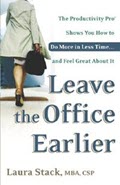I’ve recommended three top books on time management in the past. (Getting Things Done, How to Get Control of Your Time and Your Life, and The Pomodoro Technique). Each of those explains a system or philosophy of time management.
If you are looking for an integrated system to implement, read one of them. But if you want a shot in the arm to spur you to be more productive at work so you can have more time at home, read Leave the Office Earlier by Laura Stack.
The book reads part as diagnostic manual, part as encyclopedia. It opens with a 100-item questionnaire you can use to find your “Productivity Quotient.” The 100 items are then organized into chapters around 10 topics including “Reduction” (as in getting rid of things), “Discipline,” and “Vitality” (which is on the role of health in productiveness). Within a chapter there are sections of 2-3 pages each for the relevant item from the questionnaire.
Each short section is interesting, practical, and encouraging. You get specific ideas for how to solve specific problems. The advice runs the gamut from pointers on when to throw something away, to strategies for working with people who process information differently than you do. I suggest reading a few sections at a time. Put it on your bedside table and dip into it every night.
I recommend this book for its consistent can-do, optimistic approach, coupled with its fresh, essentialized look at the many issues involved in productivity. I had seen many of the ideas in some form or another, but Laura Stack presented them in an interesting way that helped me see new value in them.
For example, there are many prioritization tools that involve drawing four quadrants and labeling them, such as this:

Another variation uses “have to/don’t have to” across the top, and “want to/don’t want to” across the side, instead of urgent/important. You list your tasks in the appropriate quadrant. If possible, try to avoid tasks in the 4th quadrant: “don’t want to and don’t have to,” or “not important and not urgent.”
Laura Stack labels her quadrants differently: “high vs. low value” and “deadline vs. no deadline.” This changes the point of the exercise.

This is a subtle difference, but it changes the focus. The point becomes: try to work on high value projects with no deadline! I find this labeling much clearer and more motivating — because it focuses you on your long-range, high value goals.
I found the most interesting section in the book was the chapter in which she distinguished working hard from workaholism. Her advice had more credibility than other treatments I’ve read, because she is clearly pro-hard work. (I think you can tell that from the book. I’ve met Laura Stack, so I can testify to it. She is a productive dynamo.)
Taken together, the advice filled me with optimism and practical ideas for shifting the balance in my life. If things have gotten a bit out of control, I think you’ll find it helpful, too.









0 Comments